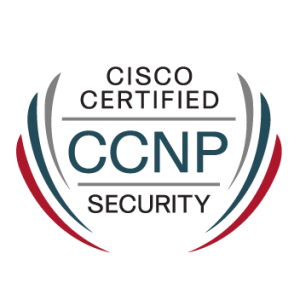
Overview
The Cisco Certified Network Professional Security or CCNP Security certification curriculum is particularly designed for the Cisco Network Security Engineer job profile,who is in charge of router, switch, networking device, and appliance security, as well as choosing, implementing, maintaining, and troubleshooting Firewalls, VPNs, and IDS/IPS solutions for their networking environments
The new CCNP Security certification curriculum equips you for today’s professional-level security technology job possibilities.CCNP Security now offers automation and programmability to assist you in scaling your security architecture.
Additionally, the National Security Agency (NSA) and the Committee on National Security Systems (CNSS) accept Cisco CCNP Security courseware as fulfilling the CNSS 4013 training requirement.
CCNP Security Exams and recommended training
You must pass two examinations to earn the CCNP Security: a core exam and a security focus exam of your choice.
The core exam assesses your understanding of security infrastructure. The core exam also serves as a prerequisite for CCIE Security certification. Candidates who pass the core test are eligible to plan and take the CCIE lab within the validity period of their core exam.
Concentration exam concentrate on new and developing subjects as well as industry-specific themes. Concentration examinations can be prepared for by taking the necessary Cisco training courses.
- 350-701 SCOR: Implementing and Operating Cisco Security Core Technologies
- 300-710 SNCF: Securing Networks with Cisco Firepower
- 300-715 SISE: Implementing and Configuring Cisco Identity Services Engine
- 300-720 SESA: Securing Email with Cisco Email Security Appliance
- 300-725 SWSA: Securing the Web with Cisco Web Security Appliance
- 300-730 SVPN: Implementing Secure Solutions with Virtual Private Networks
- 300-735 SAUTO: Automatingand Programming Cisco Security Solutions
The CCNP Security training course is suited for professionals who work with the following profiles:
- Employee
- Customer
- Reseller / Channel Partner
- There are no specific requirements for CCNP Security, however you should be familiar with the test subjects before taking it.
- Candidates for the CCNP often have three to five years of experience implementing security solutions.
The CCNP Security credential is valid for three years. When you finish qualifying things via the Cisco Continuing Education program as a Cisco certified person, you have a variety of alternatives for recertifying.
- As we have Trainees who have been completely skilled for roughly 10-15 years. Our trainers are CISCO experts, and in the real world, we provide online instruction.
- We have a single-single batch for CCNP online tutoring, with six applicants in each. There are no restrictions on the number of batches that may be attended till your membership expires.
- At each level, we will be cooperative and helpful.
Choose Your Preferred Learning Mode

1-TO-1 TRAINING
Customized schedule Learn at your dedicated hour Instant clarification of doubt Guaranteed to run
ONLINE TRAINING
Flexibility, Convenience & Time Saving More Effective Learning Cost Savings


CORPORATE TRAINING
Anytime – Across The Globe Hire A Trainer At Your Own Pace Customized Corporate Training
CCNP SECURITY COURSE OUTLINE
- Understanding the architecture of the Cisco Identity Services Engine and its access control features.
- Understanding the architecture, implementation, and functioning of 802.1X.
- Understanding the most widely used Extensible Authentication Protocols (EAP).
- Using ISE to implement Public-Key Infrastructure.
- Understanding how to set up internal and external authentication databases.
- MAC Authentication Bypass is being implemented.
- Putting identity-based permission procedures in place.
- Web Authentication and Guest Access are being implemented.
- Introducing the ISE Posture service.
- Putting ISE Profiling into Action.
- Understanding ISE allows you to bring your own device (BYOD).
- ISE Troubleshooting
- Cisco Infrastructure management and control plane security controls should be implemented.
- Configuring Cisco data plane security controls at the layer 2 and layer 3 levels.
- Putting in place and maintaining Cisco ASA Network Address Translations (NAT).
- Putting in place and maintaining Cisco IOS Software Network Address Translations (NAT).
- Creating and implementing threat protection solutions on a Cisco ASA by using access policies, application and identity-based inspection.
- Botnet Traffic Filters are being implemented.
- Putting Cisco IOS Zone-Based Policy Firewalls in Place (ZBFW).
- Set up and test the Cisco IOS ZBFW Application Inspection Policy.
- Implementing and maintaining Cisco site-to-site VPN solutions.
- Implementing and maintaining Cisco FlexVPN in point-to-point, hub-and-spoke, and spoke-to-spoke IPsec VPNs.
- Describe the various VPN technologies and deployments, as well as the cryptographic methods and protocols that ensure VPN security.
- Implementing and maintaining Cisco clientless SSL VPNs.
- Implementing and maintaining Cisco AnyConnect SSL and IPsec VPNs.
- Implementing and maintaining endpoint security and dynamic access policies (DAP).
- Learn about the Cisco ASA Next-Generation Firewall (NGFW)
- Use the Cisco Web Security appliance to protect against malware.
- Cisco Cloud Web Security Connectors must be configured.
- Configure the Web Security appliance to enforce acceptable use policies.
- Explain the Cisco Email Security Solution
- Describe the IPS Threat Controls.
- Cisco Email Appliance Configuration Policies Regarding Incoming and Outgoing Traffic
- Configure and integrate a Cisco IPS Sensor into a network.
- Use the Cisco Web Security appliance to protect against malware.
- The Cisco ASA Next-Generation Firewall: An Overview (NGFW)
- Configure the Web Security appliance to enforce acceptable use policies.
- Cisco Cloud Web Security Connectors must be configured.
- Cisco Email Appliance Configuration Policies Regarding Incoming and Outgoing Traffic
- Explain the Cisco Email Security Solution
- Describe the IPS Threat Controls.
- Configure and install a Cisco IPS Sensor in a network.
The CCNP Security certification verifies your understanding of security solutions. You must pass two examinations to obtain CCNP Security certification: one covering core security technologies and one addressing a security emphasis of your choice, allowing you to tailor your certification to your technical area of expertise.
Get In TOUCH
Frequently Asked Questions

- Log in to your Pearson VUE account.
- Enter the exam number and select Proctored Exams.
- To register, simply follow the on-screen instructions.
Once purchased, the practice examinations are available for use forever.
Cisco’s associate and professional level tests are valid for three years, whereas the specialist exam is only valid for two years.
The Cisco Network Security Engineer is in charge of ensuring the security of Routers, Switches, Networking devices, and appliances, as well as selecting, deploying, maintaining, and troubleshooting Firewalls, VPNs, and IDS/IPS solutions for their networking environments.
The training is intended for:
- network security engineers.
- Administrators of ISE
- Engineers in wireless network security
- Cisco partners and integrators
